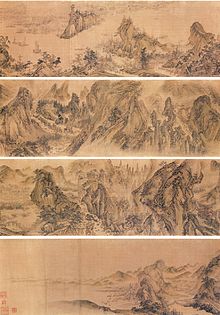Yi In-mun
Appearance
| Yi In-mun | |
| Hangul | 이인문 |
|---|---|
| Hanja | 李寅文 |
| Revised Romanization | I In-mun |
| McCune–Reischauer | Yi Inmun |
| Art name | |
| Hangul | 유춘 or 고송류수관도인 |
| Hanja | 有春 or 古松流水館道人 |
| Revised Romanization | Yuchun or Gosongnyusugwandoin |
| McCune–Reischauer | Yuch'un or Kosongnyusugwandoin |
| Courtesy name | |
| Hangul | 문욱 |
| Hanja | 文郁 |
| Revised Romanization | Munuk |
| McCune–Reischauer | Munuk |

Yi Inmun (1745-1821), also known as Yuchun, was a court painter of the late Joseon Dynasty, primarily of landscapes. He also held a military position in the court. Perhaps his best-known work is a silk scroll entitled Gangsan mujindo (Streams and Mountains Without End; hangul: 강산무진도; hanja: 江山無盡圖), which is displayed in the National Museum of Korea in Seoul.
In 1968, the American composer Alan Hovhaness (who had visited South Korea in 1963) composed a chamber symphony inspired by Yi's painting, entitled Mountains and Rivers Without End.
See also
References
- http://www.artnet.com/library/09/0928/T092841.asp accessed August 13, 2005
- http://www.metmuseum.org/toah/hd/mowa/hd_mowa.htm accessed August 13, 2005
External links
- http://www.towooart.com/oldart/old_korea/leeinmun/leeinmun.htm
- Arts of Korea, an exhibition catalog from The Metropolitan Museum of Art Libraries (fully available online as PDF), which contains material on Yi In-mun
Wikimedia Commons has media related to Yi In-mun.
